“Do not seethe (boil) a kid in its mother’s milk.”
Oh, the conundrums that this passage from the Torah has created. I’m no scholar of the subject, though I certainly studied a fair amount of it growing up. At its heart, this is one of the three kosher laws (the other being the prohibitions against pork, and against shellfish) that are probably most familiar to a widespread audience. In modern life, we take it as a given that Jewish dietary law has a consensus, a universal agreement, from throughout history, that the mixing of milk with any meat, other than fish, is prohibited, in any form. That means everything from cream sauces to cheeseburgers to chicken or meatball parmesan sandwiches, along with a host of other possibilities.
The prohibition goes further, according to some. There are waiting periods to be observed between the eating of meat or milk products. Depending on whose authority you follow that can range from half an hour to six hours. Separate cookware, serving plates and utensils, because it’s presumed, it’s simply not possible to remove all traces of one or the other, though in this modern age of piping hot dishwashers, or even just tap water, one has to imagine that the ability to do so easily is not something contemplated by the early sages. Some insist on avoiding the sharing of tables with one person who’s eating fleishig and one who’s eating milchig, the Yiddish terms.
It can also be fascinating, the lengths to which some interpreters will go to work out the logistics around the situation – sharing a table for some is permitted as long as a reminder is placed that clearly indicates which plate is which – a barrier object such as a saltshaker, or a placemat underneath one dish but not the other, are considered by some to be sufficient. The use of a non-dairy milk in cooking or presentation of meat, be it almond or soy or rice, is acceptable, but for some, it must be clearly indicated, by the presence of almonds or soybeans or rice, on the plate, as a garnish or part of the dish.
But is there universal agreement? I mean, as written, and this has been debated at length, the prohibition, which is repeated three times in the Pentateuch (Exodus 23.19 and 34.26, Deuteronomy 14.21), is worded very specifically as quoted above. Context, say the great scholars and rabbis of the ages, is all important, but they are not in complete agreement. The Exodus passages are part of prohibitions against participating in pagan, or at least, other religions’ festivals and rites, while the Deuteronomy portion is part of a list of dietary restrictions. And it’s quite specific, the term used is that of a baby goat, a kid, though the actual spelling of it, for many, seems to indicate simply a baby domestic animal, so calves and lambs would be included. Still, many, though not all, argue that the prohibition extends to baby poultry because, well, babies (or, in other interpretations, because one might mistake what sort of meat is in front of you and not be able to tell the difference between a chicken breast and a sirloin…). There are even a very few who extend this whole thing to fish, and some to eggs in certain circumstances.
While we will never know what the original writers of the various portions of these tracts truly intended, as they are long gone, the debates and commentary actually make for some fascinating reading. They delve into health and sanitation, into economics, into idolatry, mysticism, metaphor, communal identity and separatism, and even just “because it says so”. Me? I just find it fascinating, but have chosen in my life not to follow kosher dietary practices (because, well, cream sauces to cheeseburgers to chicken or meatball parmesan sandwiches, along with a host of other possibilities), and so… meat and milk, pork, shellfish… it’s all coming your way in this write-up of this last week’s dinners.
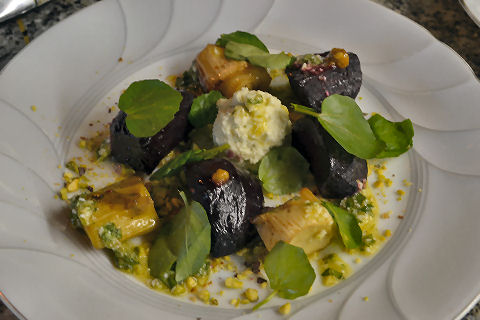
A return of our roasted beet and leek salad, a whole discussion of the development of which can be found here.
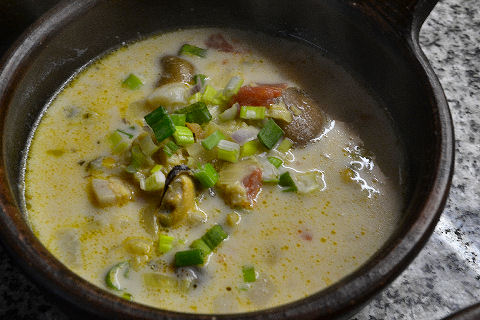
Also, a creamy and spicy caldillo, or as I think of it, Chilean chowder, with, oh my, shellfish – mussels and shrimp – as well as cod in this case, and cream! The violations start.
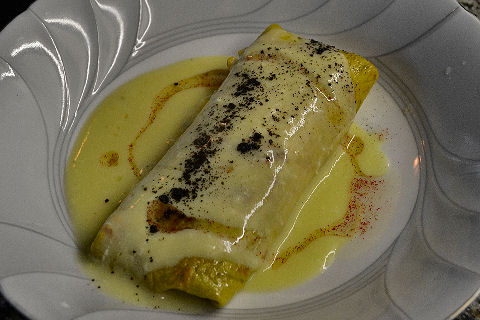
We take a respite with our charred eggplant and roasted cauliflower crepes in lemon sauce. But eggs!
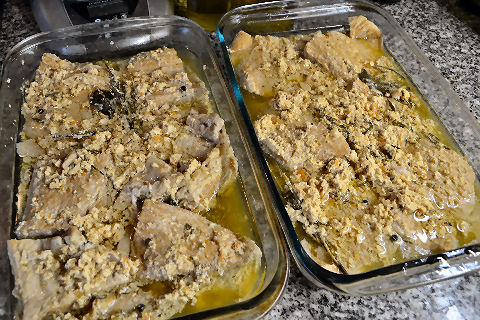
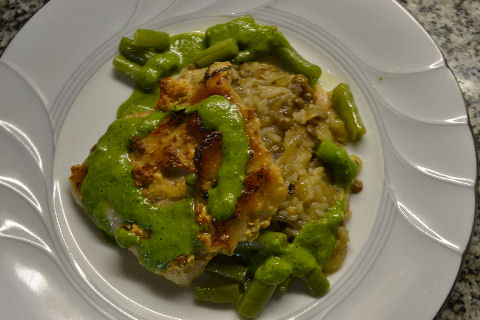
Ah, the big one here. Not only meat in milk, but pork to boot. Do two wrongs make a right? Metaphysically I have no idea, but they certainly do in deliciousness. Here, matambrito, pork flank, slowly cooked in milk infused with garlic, rocoto chilies, parsley, rosemary, thyme, bay leaf, peppercorns, mustard seeds, salt, for around six hours until it’s tender as can be without simply falling apart. The milk coagulates during the process, separating the curds and whey, as you can see in the first photo – the whey contributes to the tenderizing of the meat. At the end, a good squeeze of lemon juice over the now exposed surface of the meat, and back into the oven to brown. In this case, served with a bit of mujedrah, a classic middle eastern dish of rice, lentils and caramelized onions (with butter, oh no…), some sauteed green beans, and a quick herb sauce of parsley, rosemary and thyme. Not only yum at dinner, but leftover pieces of the matambrito made for great sandwiches the following day(s).
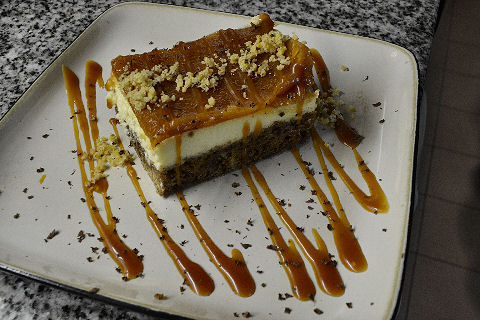
I have thrice before played around with interpretations of the classic Peruvian sweet, the King Kong. A few years ago I gave it a shot as a little tart filled with dulce de leche, quince paste, roasted cashews and fresh green figs. Not bad, but still back in the day of muddling my way towards a more cohesive cooking style. Last year, a more interesting take as a simple carob cheesecake with a honey peanut brittle and kumquats – more of a distant interpretation, but delicious. Earlier this year, a reasonably successful mashup with tiramisu, though a bit of a mess on the plate. I got to thinking, why not go more straightforward, keeping the classic flavors but changing simply the textures.
And so, at the base, a soft peanut butter and banana cookie crust, topped with a fresh pineapple cheesecake layer, and then quince paste. Over the whole thing a sea salt caramel sauce, a nut crumble, and grated chocolate. Done. Voila. Just what I envisioned.
We’re off on vacation for a month… locations to be revealed as we get to them. There probably won’t be a huge number of posts as this is primarily a family visiting trip more than it is dining out. Still, there will be some meals to record, and sights seen. There’s even a slim possibility, though it isn’t looking likely at this point, that we’ll be doing a “pop up” dinner at one point during the trip.
I remember once my friend Barbara suggesting a menu for Easter dinner that I was preparing for guests. As it turned out, all but one (I) was Jewish. Her suggestion was pork loin braised in milk. Now, you cite the double violation of cooking pork in milk, but the TRIPPLE violation of serving it to Jewish guests on Easter? As one guest put it, Frank invites us for the most anti-Semitic holiday of the year and serves us pork loin braised in milk? Doesn’t he know he takes his life in his hands with such antics?
Actually, I didn’t make or serve the dish. Instead I served my mother’s ravioli recipe, which my nephew Mo, with his TV program “My Gradmother’s Ravioli” still credits to my mother, when actually, my mother more or less adapted MY recipe when she served it to him.
Just looking at this, I’m getting hungry!
[…] yogurt. I really liked both, and particularly in combination. So, one week, I brought back the milk braised matambrito (pork flank). I cooked it in advance, cooled it, shredded it, and filled canneloni with it and a […]
[…] back the milk-braised matambrito with a different set of guarniciones – a blast from the past, wheatberries with paprika […]
[…] return of the amazing, melt in your mouth, matambrito, or pork flank, braised in milk. I’ve got the process down to an art now. And I really love the mujedrah, rice and lentils […]